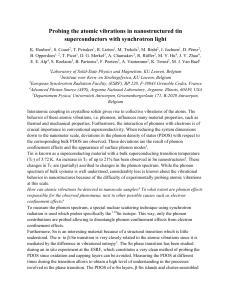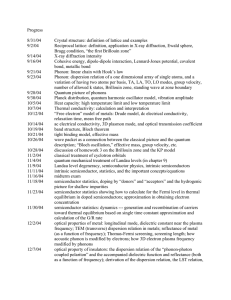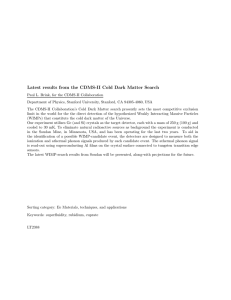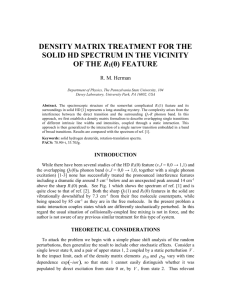IV. OPTICAL AND INFRARED SPECTROSCOPY
advertisement
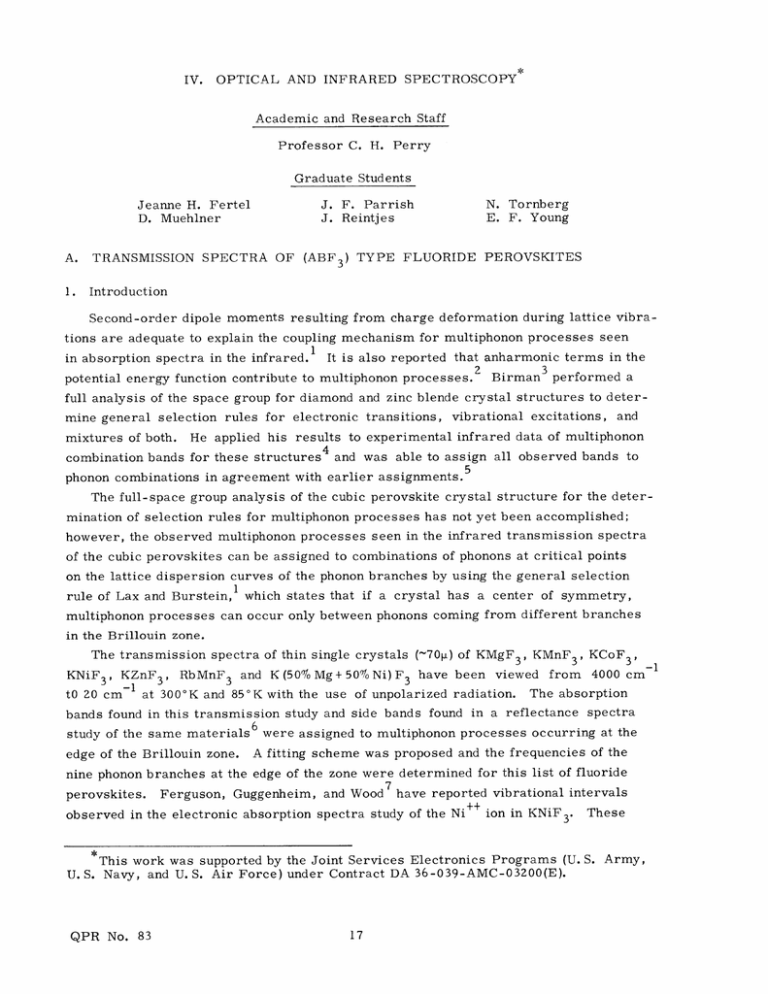
IV. OPTICAL AND INFRARED SPECTROSCOPY Academic and Research Staff Professor C. H. Perry Graduate Students Jeanne H. Fertel D. Muehlner J. J. A. TRANSMISSION SPECTRA OF (ABF 1. Introduction N. Tornberg E. F. Young F. Parrish Reintjes 3 ) TYPE FLUORIDE PEROVSKITES Second-order dipole moments resulting from charge deformation during lattice vibrations are adequate to explain the coupling mechanism for multiphonon processes seen in absorption spectra in the infrared.1 It is also reported that anharmonic terms in the 2 Birman 3 performed a potential energy function contribute to multiphonon processes. full analysis of the space group for diamond and zinc blende crystal structures to deter- mine general selection rules for electronic transitions, mixtures of both. vibrational excitations, and He applied his results to experimental infrared data of multiphonon 4 combination bands for these structures and was able to assign all observed bands to phonon combinations in agreement with earlier assignments. 5 The full-space group analysis of the cubic perovskite crystal structure for the determination of selection rules for multiphonon processes has not yet been accomplished; however, the observed multiphonon processes seen in the infrared transmission spectra of the cubic perovskites can be assigned to combinations of phonons at critical points on the lattice dispersion curves of the phonon branches by using the general selection rule of Lax and Burstein, which states that if a crystal has a center of symmetry, multiphonon processes can occur only between phonons coming from different branches in the Brillouin zone. The transmission spectra of thin single crystals (~70[) of KMgF KNiF 3 , KZnF 3 , RbMnF tO 20 cm -1 3 and K (50% Mg+ 501oNi) F 3 3 , KMnF 3 , KCoF 3 , have been viewed at 300 K and 85°K with the use of unpolarized radiation. from 4000 cm The absorption spectra bands found in this transmission study and side bands found in a reflectance study of the same materials6 were assigned to multiphonon processes occurring at the edge of the Brillouin zone. A fitting scheme was proposed and the frequencies of the nine phonon branches at the edge of the zone were determined for this list of fluoride perovskites. Ferguson, Guggenheim, and Wood 7 have reported vibrational intervals observed in the electronic absorption spectra study of the Ni++ ion in KNiF 3. These *This work was supported by the Joint Services Electronics Programs (U. S. Army, U. S. Navy, and U. S. Air Force) under Contract DA 36-039-AMC-03200(E). QPR No. 83 -1 (IV. OPTICAL AND INFRARED SPECTROSCOPY) vibrational intervals have been successfully assigned to combinations of electronic and vibrational transitions not in agreement with the assignments of Ferguson, Guggenheim, and Wood. 2. Discussion Multiphonon processes appear as continuous absorption of photons and are classified as summation processes if two or more phonons are created, or difference processes if a phonon is annihilated as well as some being created. As a crystal is cooled, summation bands become more intense and difference bands become less intense and disappear when the temperature is sufficiently low.6 Energy and momentum must be conserved for the initial and final states of the process. Table IV- 1. Frequencies of absorption bands from transmission data on thin samples. KMgF 3 KMnF 3 a. 403 775 b. 430 c. KCoF 3 KNiF 3 KZnF RbMnF 3 3 K (50% Mg + 50% Ni)F 350 324 330 333 407 810 354 351 600 710 615 363 362 745 875 d. 632 390 640 e. 667 585 790 f. 735 630 g. 762 667 h. 794 835 i. 803 1210 j. 827 k. 857 3 1. 911 m. 943 Temperature 85 0 K. -1 All frequencies in cm1 Seen with thick sample only. The experimental procedure crystals (~70 and the plotted transmission spectra of thin single thick) of the fluoride perovskites are published elsewhere. 6 The spectra exhibited the three normal vibrations of the allowed infrared active modes as large absorptions with zero transmission at the positions of the peak frequencies reflectance spectra. in the Table IV-1 lists the absorption bands in the infrared transmission spectra of thin single crystals at 85 K and the largest number of absorptions were found QPR No. 83 (IV. in KMgF 3 and KNiF 3. OPTICAL AND INFRARED SPECTROSCOPY) The mixed crystal of K (50% Mg + 50% Ni)F 3, on the other hand, had only 3 observable absorptions as compared with the 21 seen in the pure crystals of KMgF 3 and KNiF 3 . The mixing of the B-ion in the cubic ABF 3 perovskite obscures the infrared absorption bands. The absorption bands found in the transmission study of thin single crystals were temperature-dependent. The absorptions sharpened and shifted to higher frequencies upon cooling to 85 K and were relatively broad, indicating combinations of lattice vibrations. It did not seem reasonable to assign any of the noted absorptions to pure elec0 transitions, tronic as these would be normally quite sharp. The positions of the at 3000K could not be accurately located because of the broad shal- absorption peaks low nature of the bands. The -ltransmission spectrum of each crystal studied at frequencies greater than showed no noticeable absorptions, the spectra were flat at approximately 1200 cm 90 per cent transmittance, 0 and the transmission at 300 K and 85oK coincided. The cubic perovskite crystal structure has three triply degenerate infrared active optical modes, one triply degenerate optically inactive mode, and one triply degenerate acoustical mode. 8 Considering the possible polarizations and degeneracies, the cubic perovskite structure has 9 phonon branches in the Brillouin zone. They are described as follows. Z-TO 1 - transverse optical phonon (lowest frequency) i. r. active 2-TO Z - transverse optical phonon (middle frequency) i. r. active 2-TO 3 - transverse optical phonon (highest frequency) i. r. active 3-04 - optical phonon (frequency unknown) not i. r. or Raman active 1-LO 1 - longitudinal optical phonon (lowest frequency) i. r. active 1-LO2 - longitudinal optical phonon (middle frequency) i. r. active 1-LO 3 - longitudinal optical phonon (highest frequency) i. r. active 2-TA - transverse acoustical phonon (frequency unknown) 1-LA - longitudinal acoustical phonon (frequency unknown) Apart from the 0 4 , TA and LA phonon branches, the frequencies of the other phonon branches at K z 0 at the center of the Brillouin zone have been determined. The following restrictions were used to assign multiphonon processes to the observed infrared absorption bands and minor oscillators in the measured reflectance spectra. 1. To a first approximation, all crystals studied had a center of symmetry at 85°K. Therefore, Due to the large effective 2. skites 1 only combinations of phonons from different branches were allowed. 6 charges of the normal modes of the fluoride perov- and the qualitative illustration of the effect of ionicity on the vibrational spectrum of a diatomic lattice for large effective charge,5 the phonon frequencies at the edge of the Brillouin zone were as follows: a. The frequencies QPR No. 83 of the transverse optical phonon branches were equal to or (IV. OPTICAL AND INFRARED SPECTROSCOPY) slightly less than their frequencies at K z 0 at the center of the zone. b. The frequencies of the longitudinal optical phonon branches were less than their values at K z 0 at the center of the zone and decreased more than a transverse optical phonon branch when going from the center of the zone to the edge. c. The frequency of the longitudinal acoustical phonon branch was larger than the transverse acoustical phonon branch. 3. The frequency of the triply degenerate optically inactive phonon branch was unknown. This normal mode was associated, however, with an internal motion of the (BF 3 ) octahedron and it was assumed to have a frequency similar to the other internal motions of this unit. There were nine phonon branches at the edge of the Brillouin zone to contribute to multiphonon processes seen as absorption bands in transmission and minor oscillators in reflection. With these restrictions, there were a possible N= 1 n! 1 9! ---=--= 36 (n-2)! (9-2)! (1) two-phonon combinations from different branches to explain multiphonon processes. The procedure followed to assign the observed multiphonon processes to combinations of phonons from the edge of the Brillouin zone for the cubic fluoride perovskites are listed below. 1. Starting with the frequencies of the transverse phonon branches at K Z 0 at the Table IV-2. Frequencies of phonon branches at the edge of the Brillouin zone (cm KMgF 3 - 1) (85 0 K). KMnF 3 KCoF 3 KNiF 3 KZnF 3 RbMnF TO 1 162 120 132 149 135 109 TO 2 291 191 218 241 195 193 TO3 471 414 445 450 424 386 04 442 325 365 387 338 311 LO 1 181 141 150 150 146 120 LO 2 335 241 255 282 216 224 LO 3 504 450 * 517 452 434 LA 94 70 90 82 70 90 TA 70 64 81 70 66 80 Not assigned due to a lack of available multiphonon processes. QPR No. 83 3 (IV. center of the zone, OPTICAL AND INFRARED SPECTROSCOPY) these frequencies were adjusted until two-phonon combinations of them agreed with as many observed multiphonon processes as possible consistent with the stated restrictions. The fitted frequencies were then assigned to the frequencies of the transverse optical phonon branches at the edge of the zone. 2. The frequencies of the transverse optical phonon branches at the edge of the zone were subtracted from the remaining observed multiphonon processes. repeated in this list of subtractions Numbers which were chosen as possible frequencies phonon branches at the edge of the zone. of unknown This procedure was followed in choosing the remaining six unknown phonon branch frequencies at the edge of the zone and the frequencies were assigned to phonon branches with the help of the list of restrictions placed on the branches. Tables IV-2 through IV-5 list the frequencies of the phonon branches at the edge of the Brillouin zone and the assignments determined from the best fit to the observed multiphonon absorptions. Ferguson, Guggenheim, and Wood 7 have observed vibrational intervals in their study of electronic absorption spectra of the Ni ++ ion in KNiF temperatures. In a second paper, 9 3 with thin samples at helium they assigned the observed vibrational intervals to combinations of K z 0 optical (transverse) phonon modes with forbidden electronic transitions. The phonons break down the selection rules for forbidden electric dipole transi3 - 3 Ta A tions. The first four frequencies observed by them in each of the 3 A 1 3 36 2g 1g' 2g T Zg and A 2 g T 1 transitions were assigned to combinations of the forbidden elec- tronic transition with one of the four transverse optical phonons at K Z 0 from the center of the Brillouin zone. They used the vibrational intervals as a basis for this assignment. A study of their vibrational intervals and the phonon branch frequencies at K center of the zone and at the edge of the zone 6 = 0 at the have led to the electronic-vibrational assignments given in Table IV-6. The frequencies of the phonon branches at the edge and at K z 0 at the center of the measurements at 4oK. 0 while Ferguson, Guggenheim, and Wood7 made their -1 The value of 469 cm-1 assigned to the TO 3 branch at K = 0 at Brillouin zone were for 85 K, the center of the zone to fit the vibrational intervals was a reasonable assignment for the frequency of the transverse optical phonon branch of KNiF 3 at 4°K since this phonon frequency increased as the crystal was cooled from 300'K to 85'K. The frequencies of the remaining phonons were not changed for the assignments of the vibrational intervals at 4°K and the calculated vibrational intervals Table IV-6 were very close to those reported.7 for the assignments listed in The first absorption reported by Ferguson, Guggenheim, and Wood 7 was assigned here to the transverse acoustical mode at the edge of the Brillouin zone, the next four, to the transverse optical phonon modes at K ; 0 at the center of the zone in the order of increasing frequency. of increasing frequency. QPR No. 83 This gave a frequency of 387 cm-1 for the triply degenerate This gave a frequency of 387 cm for the triply degenerate Multiphonon assignments to experimental data (85 0 K). Table IV-3. KMgF KNiF 3 Assignment and calculated frequency Obs erved freq uency 4C03 4 30 3 Assignment and calculate d frequency Observed frequency LO 2 + TA = 405 324 TO 2 + LA = 323 TO 3 - TA = 401 354 LO 2 + TA = 352 LO 2 + LA = 429 363 LO 2 + LA = 364 LO 3 - TA = 434 390 TO 1 + TO 4 99 TO1 + LO 2 = 497 470 5 16 LO 2 = 516 521 TO 2 + LO TO 3 + TA = 541 585 LO 3 + TA 6115 TO 3 + TA + TA = 611 630 TO 2 + 6: 32 TO 1 + TO 3 = 633 667 TO 1 + LO 6 67 T0 3 = 666 835 TO 7135 TO 2 + 0 4 = 733 1210 7 62 TO 2 + TO 3 = 762 7 94 TO 8(03 TO 5 41 1 1 2 3 + L0 + LO + LO 3 = 795 + L0 2 = 806 0 4 + TO 2 = 827 8 27 LA + 8 57 LA + TO 3 + TO 2 = 856 9 11 TO 9 43 LO 3 3 + 04 = 913 + 0 4 Seen in reflection. tDifference bands. All frequencies in (cm QPR No. 83 - ). = 946 2 = 469 0 4 + LA 3 + = 390 2 = 523 = 587 0 4 = 628 3 = 666 0 4 = 837 TO 3 + LO 3 + TO 2 1208 Table IV-4. Multiphonon assignments to experimental data (85 0 K). K (50% Mg + 50% Ni) F 3 Observed frequency Assignment and calculated frequency = 405 + TA 407 LO 527 TO 2 + LO 2 = 523 710 2 TO 1 + 04 = 536 LO 1 + 04 = 537 TO 3 + LA = 532 TO 3 + TA = 520 04 + LA = 536 Pure crystal (KMgF 3 ) (KNiF 3 ) (KMgF TO 2 + TO 3 = 691 (KNiF 3 ) 3) LO 2 + TO 3 = 732 TO 2 + 875 0 4 (KMgF 3 ) = 733 11 LO 1 + LO 3 = 685 TO 1 + TO 3 + LO 2 = 88 2 = 86 9 TA + LO 3 + L0 LA + LO 3 + LO 2 = 88 1 2 + LO 2 + LA = 82 1 TO 3 + LO 2 + TA = 87 6 TO 2 + LO 3 + LA = 88 9 0 4 LO 1 + LO 1 + LO3 = 88 6 Seen in reflection. All frequencies in (cm-l All frequencies in (cm QPR No. 83 ) (KNiF 3 ) It (KMgF "T 3 ) Table IV-5. KMnF Multiphonon assignments to experimental data (85 KCoF 3 Assignment and calculated frequency Observed frequency *261 KZnF K). 3 Observed frequency Assignment and calculated frequency = 261 231 LO1 + TA = 231 - TA = 261 240 LO1 + LA = 240 TO 2 + LA = 261 350 TO1 + TO 2 = 350 432 TO Z + LO 2 = 432 473 TO 2 + LO 2 = 473 445 TO + 0 4 = 445 810 TO 3 + 775 LO 3 + 0 4 = 775 TO 1 + L0 0 4 1 1 RbMnF 3 Assignment and calculated frequency Observed frequency 04 = 810 3 Observed frequency Assignment and calculated frequency 201 TA + TO 1 = 201 205 LA + TO1 = 205 330 TO 2 + TO 1 = 330 333 TO 351 LO 2 + TO 1 = 351 420 TO 2 + L0 2 = 417 362 LO1 + LO 2 = 362 TO1 + 0 4 = 420 473 TO 1 + 0 4 = 473 431 LO1 + 0 4 = 431 640 TO 3 + L0 2 = 640 600 TO 3 + LO 2 = 610 790 LO 3 + 4 = 790 745 LO 3 + Seen in reflection. tDifference band. All frequencies in (cm QPR No. 83 0 - 1 0 200 TO + LA = 199 LO + TA = 200 1 + LO 2 = 333 04 = 745 OPTICAL AND INFRARED SPECTROSCOPY) (IV. Assignment of electronic-vibrational spectrum of KNiF Table IV-6. 7 Ferguson, Guggenheim, Measured vibrational interval (° K) 3 reported by and Wood. Assignment Calculated vibrational interval Pure electronic (E) E + TA(e) = E + 70 81 E + TOl(c) = E + 150 177 E + TO2(c) = E + 248 178 317 E + 0 4 (c)= E + 387 317 399 E + TO 3 (c) = E + 469 399 487 E + T0 2 (c) + L0 2 (c) = E + 556 486 546 E + LO 2 (c) + LO 2 (c) = E + 616 546 625 E + LO (c) + (c) = E + 695 625 709 E + LO 3 (c) + T0 2 (c) = E + 782 712 832 E + LO 3 (e) + (e) = E + 904 834 0 0 4 4 (c) Phonon at K z 0 from center of Brillouin zone. (e) Phonon from edge of Brillouin zone. All frequencies in (cm-). optically inactive mode, agreeing with the assignment made earlier (see Table IV-2). The remaining vibrational intervals were assigned to multiphonon processes. E. F. Young, C. H. Perry References Lax and E. Burstein, Phys. Rev. 97, 39 (1955). 1. M. 2. B. Szigeti, 3. J. L. Birman, Phys. Rev. 127, 1093 (1962). 4. J. L. Birman, Phys. Rev. 131, 1489 (1963). 5. R. W. Keyes, J. 6. E. F. 7. J. 8. G. R. Hunt, 9. J. Proc. Roy. Soc. Chem. Phys. Young, Ph. D. Thesis, Ferguson, H. J. 37, 72 (1962). M. I. T. , August 22, 1966. Guggenheim, and D. C. H. Perry, and J. Ferguson and H. J. QPR No. 83 (London) A252, 217 (1959). L. Wood, J. Chem. Phys. 40, 822 (1964). Ferguson, Phys. Rev. 134, A688 (1964). Guggenheim, J. Chem. Phys. 44, 1095 (1966). (IV. B. OPTICAL AND INFRARED SPECTROSCOPY) FERROELECTRIC "SOFT" MODE IN KTaO 3 Far infrared reflectance measurements have been made on single crystals KTaO, -I from 40-1000 microns (250-10 cm ) over the temperature range 12-463 0 K. The reflectance data were analyzed using a Kramers-Kronig method to obtain total conductivity, a-, from the imaginary part of the dielectric constant. The conductivity exhibits -i a very strong temperature dependent low-frequency peak which moves from 106 cm-1 at 463 K, -i to 25 cm-1 at 12 0 K and accounts for more than 90 per cent of the static dielectric constant, E . The results indicate a relationship between this low transverse optical mode, c t i for k z 0 and the static dielectric constant E , such that 1 c 2 t (T) = A/o 10 (T) where A = 1. 9 x 106 (cm-1). 2 This result can be related directly to the Curie-Weiss law behavior of ferroelectrics and the associated implications have been derived and 1-3 discussed by several authors. Consequently, the experimental verification in the case of KTaO 3 helps confirm the theory of ferroelectricity in perovskite type materials which indicate a soft mode lowering its frequency and becoming unstable as the temperature is lowered towards the Curie point. This phenomenon had previously only been observed with any certainty for SrTiO3 using far infrared 4 and neutron techniques. 5 The infrared reflectance measurements at a 100 angle of incidence were performed on a Michelson spectrophotometer6 using several beam splitters and a liquid-helium cooled germanium detector. The sample was mounted in a separately evacuable chamber and its temperature was measured with two calibrated thermocouples attached to the crystal. The complete temperature range could be accomplished without disturbing the sample and mount. -l The total reflectivity curve from 10-4000 cm-1 was measured at 296 K, and also -1 at 126°K but very little temperature dependence of the modes at about 200 cm 550 cm-1 and the side band at 760 cm-1 was observed. The results at room temperature agreed closely with those of Miller and Spitzer7 and reference should be made to their -1 work for the complete spectrum. Between 0-10 cm the extrapolated curves were in good agreement with the reflectivity values calculated from the static dielectric constant measurements of Rupprecht and Bell 8 and Davis. 9 Beyond 250 cm - 1, the reflectance curve measured at room temperature was used with the high temperature and room temperature data, while the 126°K curve was coupled with the measurements at other temperatures in order to evaluate the far infrared complex dielectric constant from the Kramers-Kronig analysis. The marked temperature dependence of the reflectivity curve below 100 cm-1 can be clearly seen in Fig. IV-1, curve below 100 cm can be clearly seen in Fig. IV-1, QPR No. 83 together with the weakly together with the weakly OPTICAL AND INFRARED SPECTROSCOPY) (IV. dependent temperature The frequencies 200 cm at mode -1 . of the normal optically active transverse modes were derived in from peaks 90 -. = E'w/2 and E' is the J th 3 resonance to contribution of the j ar(w), where 126 oK 100-2 oK the imaginary part of the dielectric 10 constant. 80 70 conductivity the 463 60- The frequency dependence of the 50- conductivity with temperature below 40 170 cm -1 the positions of the "soft" 30- 30 I0 - , 180 190 80 120 S I I I I I i t I 40 160 200 240 WAVE NUMBER (CM ') by varying the low frequency input data to the K-K analysis over the limit of the error of Far infrared reflectivity KTaO 3 as a function of tempera- Fig. IV- 1. mode are estimated to be accurate to about -l ±5 cm 1 .- This estimate was obtained 20 0- is shown in Fig. IV-2 and over the frequency range -1 in The error 10-250 cm . measurements =+2%. ture the (±2%) in reflectance measurements. The temperature dependence of the transverse optical modes are given in Table IV-7. The static dielectric constant E0 can be written in terms of the Curie 30- 0 12 K law o 1 T -T o 2 20 b > c and consequently Wt ccT-T c Meas- urements of E for KTaO 3 at micro- 15 wave frequencies by Rupprecht and 10 z 0 Bell 8 from 80-303 0 K have indicated 10 a modified Curie law behavior such that E o 05 B T-T + C, where B= 5.98 9 X c 104 K, C = 39. 32 and the Curie tem40 Fig. IV-2. 120 100 80 60 WAVE NUMBER (CM ') Conductivity calculated from the curves shown in reflectivity Fig. IV-1 for the five diffe rent temperatures. QPR No. 83 0 perature Tc = 2. 9 K. This result is shown by the solid curve in Fig. IV-3 together with the temperature dependence of the low frequency mode. The upper four points fall closely on the 10 3 100.0 20.0 10.0 70 T -I (oK- I) 5.0 4.0 iF\/VIATIOINI 6.0 FRPM\A RIPI 2.5 1 ,.uI 2.0 I A\A/ 12.0 ( DAVIS) 0.5 10.0 5.0 &0 8.0 S0 4.0 o 0.0 re() o 20 10 30 6.0 cj - 3 MODIFIED CURIE LAW 2.0 - B U T-Tc / . 4.0 +C o 2.0 (RUPPRECHT 8 BELL) . .. 50 100 150 200 250 i i i 300 350 400 450 10 500 T (oK) Fig. IV-3. The square of the frequency (in cm - ) of the ferroelectric "soft" mode plotted as a function of temperature. Vertical lines indi2 cate the wtl error and horizontal lines show the temperature variation. The solid curve shows the reciprocal of the dielectric constant from the results of Rupprecht and Bell. The extrapolated curves gives a Curie temperature of 2. 9 0 K. The dotted curve shows the low-temperature deviation (below 30'K) from the modified Curie law (R & B) obtained by Davis. Table IV-7. * The transverse optical modes in KTaO as a 3 function of temperature. ToK tI t2 12 25 196 126 58 198 551 232 79 198 551 295 88 199 550 463 106 199 - 7 See Miller and Spitzer' for complete spectrum. QPR No. 83 t3 (IV. OPTICAL AND INFRARED SPECTROSCOPY) modified Curie law described by Rupprecht and Bell but the experimental error in barely excludes normal Curie law behavior. Davis constant below 80 0 9 2tl has recently measured the dielectric K and has found deviations from the Curie law under 300K. The one 0 measured frequency in this region (~12 K) also indicates a value corresponding to devi- ations found by Davis. The extremely low "Curie temperature" makes this crystal ideal for the investigation of the "soft" mode in the paraelectric cubic state. The temperature variation of this vibration is in good agreement with the temperature dependence of the dielectric constant related by the Cochran-Cowley theory of ferroeletricity in perov- skite crystals. We would like to thank Professor A. Smakula, Materials Center for Science and Engineering, Massachusetts Institute of Technology, for the sample. All computations were performed on the IBM 7094 computer at the M. I. T. Computation Center. C. H. Perry, T. F. McNelly [T. F. McNelly is now in the Physics Department, Cornell University. His work was supported in part by Air Force Cambridge Research Laboratories under contract number AFl9-(628)-395.] References edited by N. F. Mott (Taylor and Francis, Ltd., 1. W. Cochran, Advances in Physics, London, 1960), Vol. 9, p. 387. 2. P. W. Anderson, Fizika Dielectrikov, edited by G. I. Skanavi (Akad. Nauk S. S. S. R. Fizicheskii Inst. im P. N. Lebedeva, Moscow, 1960). 3. T. Nakamura, The Institute for Solid State Physics, 1 (1966). J. Phys. Soc. Japan, p. 491 (1966). 4. A. S. Barker, Jr. and M. Tinkham, 5. R. A. Cowley, 6. C. H. 7. R. C. Miller and W. G. Spitzer, 8. G. Rupprecht and R. O. Bell, Phys. Rev. 135, A748 (1964). 9. T. G. Davis, S. M. 10. 11. Phys. Rev. Phys. Rev. 125, Letters 9, Perry, R. Geick, and E. F. Tokyo, Japan, Ser. A, 1527 (1962). 159 (1962). Young, Applied Optics 5, 1171 (1966). Phys. Rev. 129, 94 (1963). Thesis, Department of Electrical Engineering, M. I. T. F. Seitz, Modern Theory of Solids (McGraw-Hill Book Co. , New York, Chap. XVII, p. 635. W. Cochran and R. A. Cowley, J. Phys. Chem. Solids 23, 447 (1962). QPR No. 83 186, (1966). 1940),


